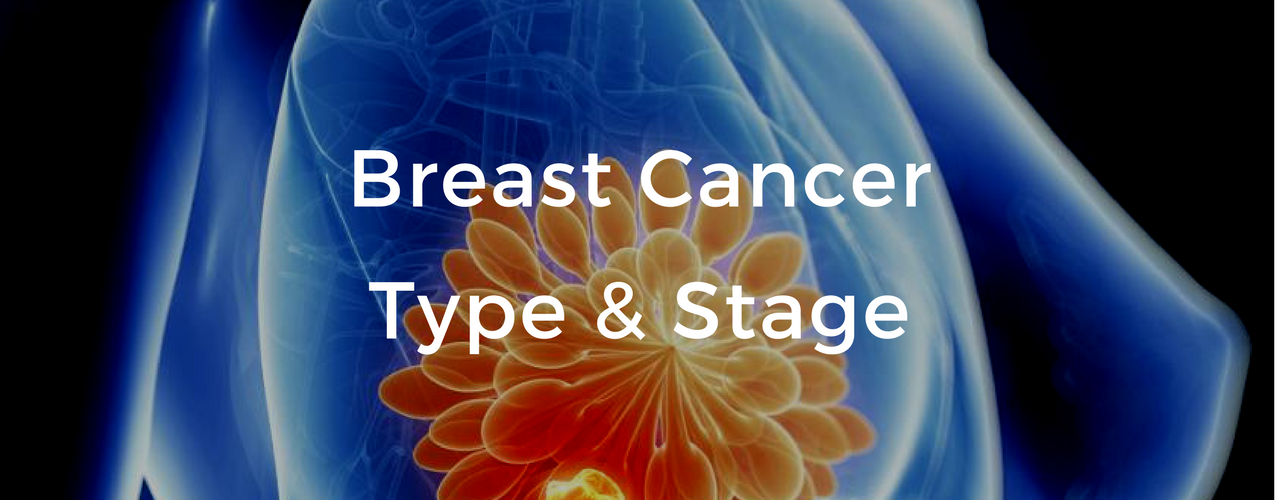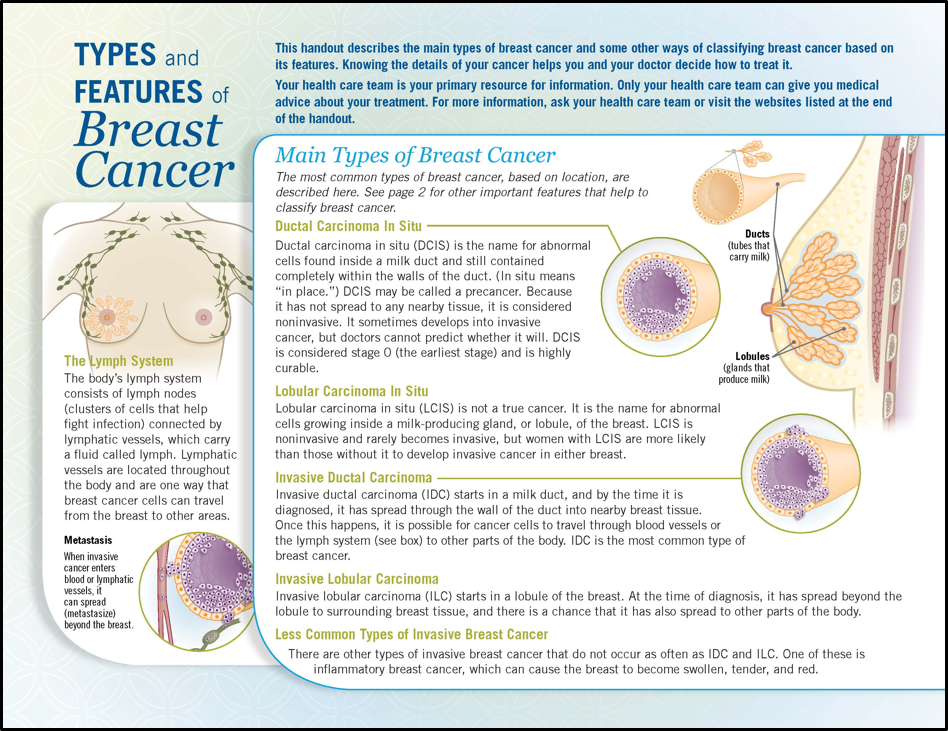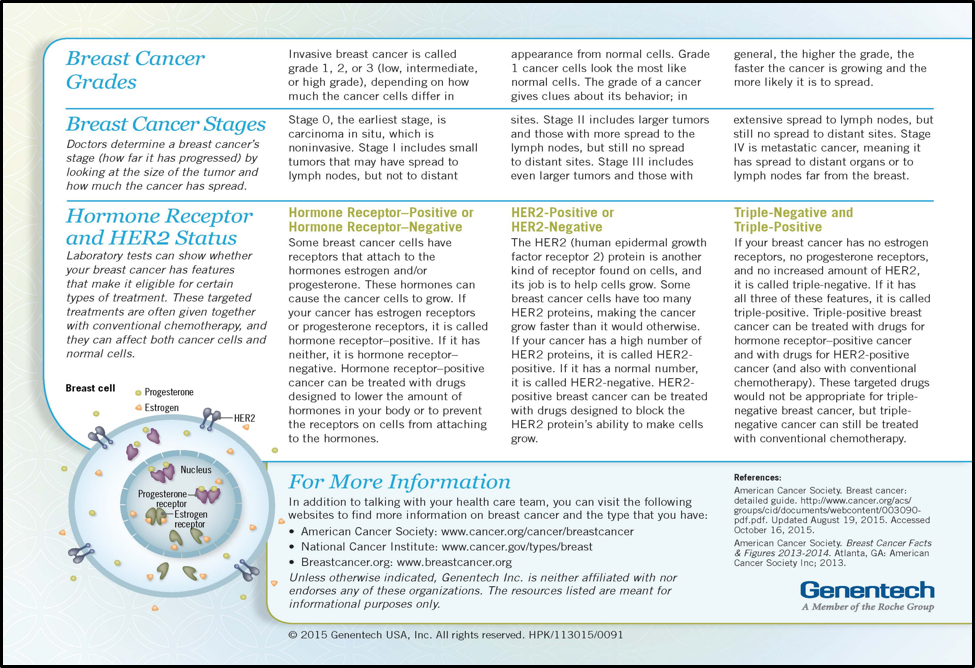Questions for your Breast Cancer Specialists:
- What type of breast cancer do I have?
- Can you explain my breast cancer stage and what it means?
- How much of a threat to my life is my stage of cancer?
Breast Cancer Type:
Breast cancer “type” is a general reference to the unique features of breast cancer cells. Most important is if the tumor is considered invasive or non-invasive. “Cell type” and “receptors” are also important. These are some of the puzzle pieces that you and your breast specialists must put together to fully understand your breast cancer and how to best treat it.
Invasive breast cancer:
Invasive breast cancer cells may have the ability to spread beyond the breast to the lymph nodes and other organs of the body. Although this is the type of cancer that can threaten one’s life, 90% of all invasive breast cancers are cured by modern day cancer treatment. “Invasive Breast Cancer“ is covered in great detail with our video lesson (here).
The two most common “cell types” of invasive breast cancer are Infiltrating Ductal Carcinoma (IDC) (70%) and Infiltrating Lobular Carcinoma (ILC) (20%). They both are treated in almost the same fashion with a combination of surgery, possibly chemotherapy, hormonal therapy, and radiation therapy. There are other less common cell types of invasive breast cancer which are not covered in this course. These include papillary, mucinous, colloid, tubular, and phyllodes to name a few.
Non-invasive breast cancer:
Non-invasive breast cancer is generally defined as DCIS (Ductal Carcinoma In-Situ). It does not spread to the lymph nodes or beyond. Think of DCIS as a “pre-cancerous” area of the breast. An invasive cancer may evolve from an area of DCIS over time if it is untreated and left in the body to grow. Learn more about “Non-Invasive DCIS“ with our video lesson (here).
Breast Cancer Stage:
Stage is a way of estimating how life-threatening a cancer is based on the “size” of the tumor, if cancer involves the lymph nodes, and if it has spread to other parts of the body. There are many other important cancer factors beyond stage that determine how a breast cancer should be treated. The term “stage” is often confused with tumor “grade.” Tumor grade is a reference to how abnormal the cancer cells appear under the microscope. Stage of cancer is a reference to how extensive the breast cancer was at the time of diagnosis.
Non-Invasive Breast Cancer:
(Stage 0)
This refers to the presence of DCIS without evidence of invasive breast cancer. The size of the tumor can be small or large. A lumpectomy, followed by radiation to the breast, is the most common treatment approach. A mastectomy may be required to remove a large area of DCIS in some situations. Surgery is the first treatment for Stage 0 breast cancer.
Early Stage Invasive Breast Cancer:
(Stage I)
The invasive cancer tumor is smaller than 2 cm and there is no evidence that cancer has spread to the axillary lymph nodes. Surgery is usually the first treatment. Infrequently, chemotherapy before or after surgery is sometimes needed.
(Stage II)
The most common scenario is that the tumor is larger than 2 cm but smaller than 5 cm without evidence of spread to the axillary lymph nodes. Another scenario is that the tumor is less than 5 cm in size and there is evidence of cancer in a few axillary lymph nodes. Surgery or chemotherapy are often the first treatment options.
Later Stage Breast Cancer:
(Stage III)
These cancers are generally much larger tumors and in a few situations have grown into the skin or the chest wall. Many have already spread to the axillary lymph nodes. The cancer can grow in a way that involves other tissue around the tumor that makes it difficult to remove surgically. Stage III cancer also includes “inflammatory breast cancer.” There is no evidence of cancer spreading to other body sites yet in Stage III breast cancer. Chemotherapy is usually the first treatment.
(Stage IV)
Any breast cancer that is found to have spread to other parts of the body (distant metastasis) is Stage IV. The size of the tumor and involvement of the lymph nodes is still important information for treatment decisions. The fact that cancer has spread elsewhere reflects the life-threatening nature of Stage IV breast cancer. Chemotherapy or hormonal therapy is usually the first treatment.
Patient-Friendly References:
This page (here) has one of the best and more concise descriptions of staging. This educational site is created for patients by the American Society of Breast Surgeons.
The “Breast Cancer Staging and Stages” page (here) is a simplified outline of how physicians stage breast cancer. The Susan G. Komen organization is a leading advocacy group dedicated to assisting patients, funding research, and ensuring quality breast cancer care.
- NCCN Guidelines for Patients (Stage 0 Breast Cancer)
This ”Stage 0 Breast Cancer” booklet (here) is a comprehensive resource for patients with DCIS or LCIS. The NCCN is a consortium of organizations and governmental agencies to promote quality breast cancer care.
- NCCN Guidelines for Patients (Stage I & II Breast Cancer)
This ”Early Stage Breast Cancer” booklet (here) is a comprehensive resource for patients with Stage I and II breast cancer. The NCCN is a consortium of organizations and governmental agencies to promote quality breast cancer care.
- NCCN Guidelines for Patients (Stage III Breast Cancer)
This ”Stage III Breast Cancer” booklet (here) is a comprehensive resource for patients with more advanced but not metastatic breast cancer. The NCCN is a consortium of organizations and governmental agencies to promote quality breast cancer care.
- NCCN Guidelines for Patients (Stage IV Breast Cancer)
This ”Stage IV Breast Cancer” booklet (here) is a comprehensive resource for patients with metastatic breast cancer. This “NCCN Quick Guide: Stage IV Breast Cancer” (here) is also an excellent resource. The NCCN is a consortium of organizations and governmental agencies to promote quality breast cancer care.
More Detailed References:
The “Stages of Breast Cancer” page (here) is a very good summary. This non-profit organization provides excellent patient resources about breast cancer.
The page (here) about “How Breast Cancer is Staged” is a detailed overview of the specific criteria for breast cancer staging. The American Cancer Society is an organization that supports patients with cancer and funds research for cancer of all types.





